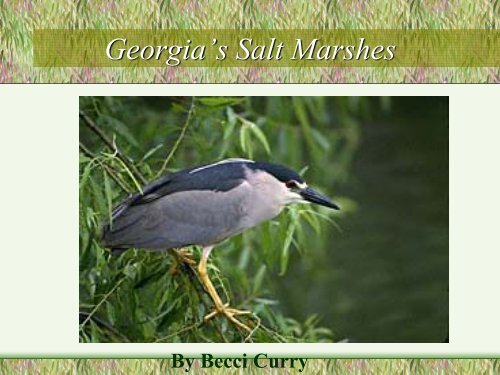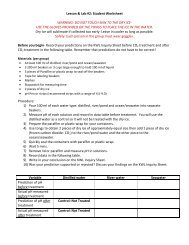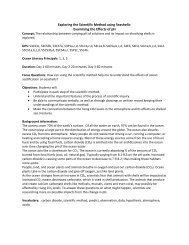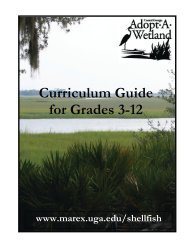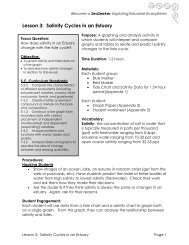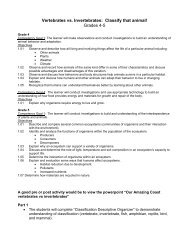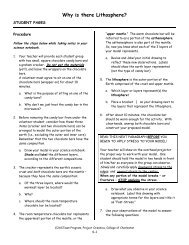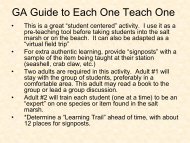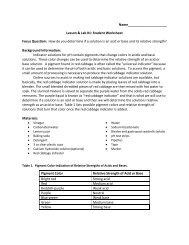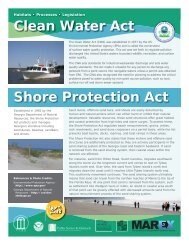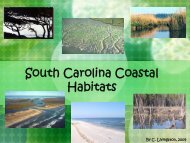You also want an ePaper? Increase the reach of your titles
YUMPU automatically turns print PDFs into web optimized ePapers that Google loves.
Georgia’s <strong>Salt</strong> <strong>Marsh</strong>es<br />
By Becci Curry
Where are they?<br />
• Georgia’s coastal<br />
marshlands encompass<br />
approximately 475,000<br />
acres in a 4-6 mile band<br />
behind the barrier<br />
islands.<br />
• Georgia has over one<br />
third of the salt marsh on<br />
the entire Atlantic coast.
What lives in a marsh?<br />
• Look closely and you<br />
will soon discover that<br />
the marsh is alive with<br />
many interesting<br />
creatures…<br />
• This marsh crab is<br />
hard at work sifting<br />
through the detritus<br />
for his dinner!
• Other animals that<br />
depend on detritus<br />
are fiddle crabs…<br />
• This is a male<br />
fiddler. Check out<br />
his large claw;<br />
used for eating,<br />
defending himself,<br />
and waving at the<br />
ladies!
Blue Crab<br />
• The blue crab<br />
is one of the<br />
top predators<br />
in the marsh.<br />
It eats snails,<br />
fish, and small<br />
crabs.
• Mud snails think that<br />
detritus is yummy!<br />
• What’s detritus???<br />
• Detritus is dead and<br />
decaying plant and<br />
animal matter.
• Periwinkle snails<br />
live their lives<br />
sliding up and<br />
down marsh<br />
grass. As the<br />
tides come and<br />
go, they lick the<br />
algae that collects<br />
there …whew!
• I hear that if<br />
you hum to<br />
them, they will<br />
come out to<br />
say hello.<br />
• But…you have<br />
to be patient!
• Coffee bean<br />
snails graze on<br />
dead and<br />
decaying<br />
Spartina in the<br />
higher marsh.
Ribbed Mussels<br />
• Ribbed<br />
mussels have<br />
“Bissell<br />
threads” that<br />
act like roots<br />
to keep them<br />
from washing<br />
out to sea.<br />
They are filter<br />
feeders.
Oysters<br />
• The oysters that we<br />
have here are not<br />
very tasty. They are<br />
exposed to the dry air<br />
often and covered in<br />
anoxic mud. They<br />
would taste like the<br />
marsh smells. They<br />
are filter feeders.
Diamondback Terrapin<br />
• Scutes bear deep growth<br />
rings<br />
• Habitat salt-marsh<br />
estuaries, tidal flats, and<br />
lagoons<br />
• They feed on marine<br />
snails, clams, and<br />
worms<br />
• Development of coastal<br />
marshes destroyed much<br />
of their habitat
The plants in the marsh have many<br />
special adaptations.<br />
Smooth Cord Grass or Spartina<br />
Black Needle Rush<br />
<strong>Marsh</strong> elder
<strong>Marsh</strong> Elder<br />
Glasswort
• Some Georgia resident birds nest in the marsh, as<br />
well as many migratory species.
White Ibis<br />
Wood Stork
American Bittern<br />
Great American Egret
Double-crested Cormorant<br />
Great Blue Heron
• The marshes serve as<br />
a nursery ground for<br />
juvenile fish and<br />
shellfish, that have<br />
sport as well as<br />
commercial value.<br />
About 70% of fish<br />
that are harvested<br />
commercially spend a<br />
portion of their lives<br />
in the marsh system.
• The marshes act as a buffer, which protect the<br />
upland areas, from the forces of storms and tides.
• The marshes and<br />
estuaries also serve as<br />
a tertiary treatment<br />
facility.<br />
• The marsh grass and<br />
sediments act as a sink<br />
and pump, adding<br />
large amounts of<br />
nutrients to the sea.
• The scenic beauty of<br />
the marsh attracts<br />
many visitors.<br />
• Many people enjoy<br />
boating, canoeing,<br />
birding, or just wading<br />
around in this diverse<br />
habitat.
• The next time you get a chance, go “marsh<br />
mucking”. You never know what you’ll see...
See you later, alligator!
Our Estuary<br />
• Between the mainland<br />
& barrier islands<br />
• Where fresh & salty<br />
water mix<br />
• Habitats include: salt<br />
marsh, mud flats,<br />
sounds, tidal creeks
• Rain water brings<br />
dissolved minerals,<br />
chemicals, materials<br />
from land<br />
• Mixes with nutrients<br />
in the salt water to<br />
create biologically<br />
productive system
The Fouling Community<br />
• The plants and animals<br />
that live on or near the<br />
docks & pilings<br />
• Free floating (plankton)<br />
• Sessile (barnacles,<br />
tunicates)<br />
• Mobile (inverts)
Plankton: Free Floaters<br />
• Zooplankton: animal<br />
*copepods (oar-foot)<br />
• Phytoplankton: plant<br />
*diatoms: y/g algae,<br />
dinoflagellates<br />
• Meroplankton: temp.<br />
crab, barnacle larvae<br />
• Lesson Plans!


